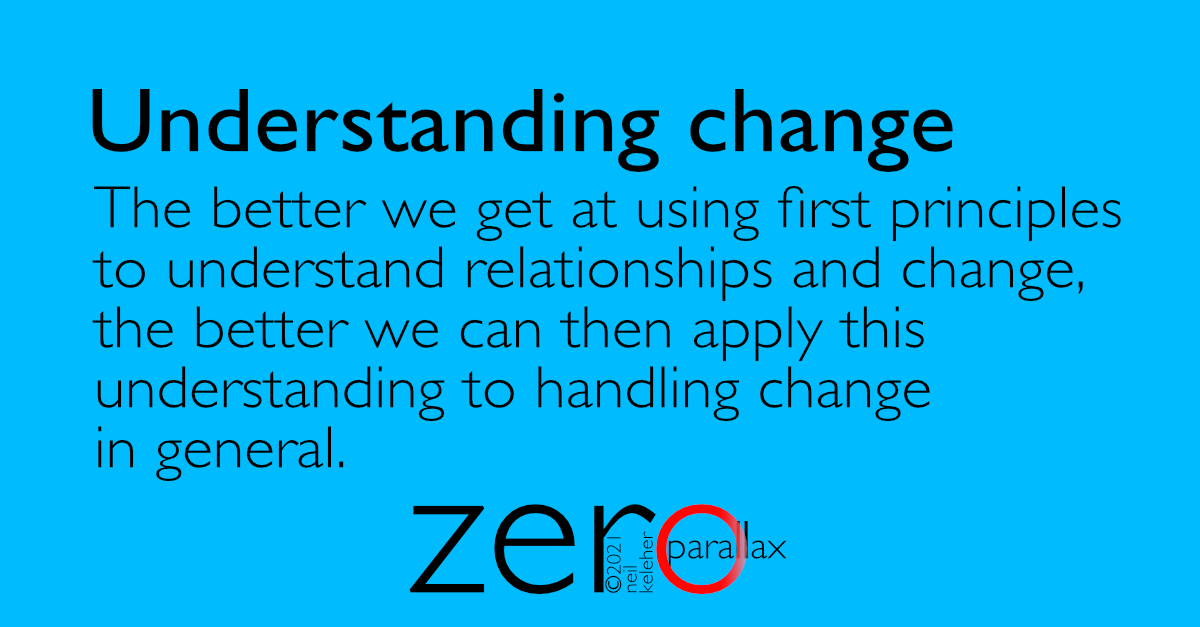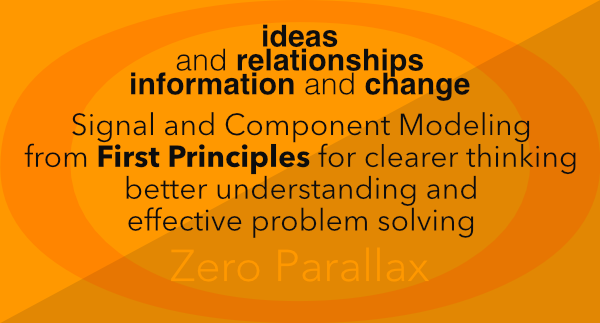Relationships as a context for change

Where ideas are the potential for change, like the component parts of a system viewed separately from the system (like a battery taken from a torch), relationships are where change actually occurs.
In a system that is actually working, a relationship provides the context for viewing change as it is transmitted from one idea to the other.
Laplace transforms and switching points of view
Laplace transforms are something we learned about while in engineering school. It's a method of switching points of view to make solving some types of problems easier. You change your point of view, solve the problem, and then switch back to the original point of view or perspective.
As an example, there are types of equations that can be used to describe circles. There are also equations that can be used to describe sinusoidal wave forms. With Laplace transforms,we can switch between these two types of equation.
Why might we want to do this?
Sometimes one type of equation is easier to solve than the other. So we switch views, solve the equation from this different perspective, and then switch back to the original perspective.
Now why would we switch between equations for a circle and equations for a sinusoid?
Because they are two different views of the same thing. If we take a spiral, then a circle is the view of that spiral when viewed from the end. Meanwhile the sinusoid is what you get when you view a spiral from the side.
Ideas and relationships are similiar.
Ideas and Relationships
Ideas and relationships give you complimentary views of the same thing.
We can look at a system as a set of component parts, the idea view. We can also look at a system as a set of interconnected relationships. This is the relationship or "signals" view.
Relationships are made up of two connected ideas.
Understanding a system in terms of ideas and relationships
When we understand all of the component ideas as well as how they relate, we understand the system as the sum of those ideas and relationships.
When we understand the relationships we understand how the system is supposed to work. However, when we understand the ideas that make it up, we also then have the possibility of being able to adapt the system when the need arises.
Driving and navigating
These two ways of viewing a system is very much akin to an artist painting or sculpting and then taking a step back to view the painting from afar. Taking a step back allows them to see what they are doing in the context of the whole so that they can make changes if they choose.
It could also be likened to driving, then taking a stop (pre-GPS) to take a look at a map to see whether we are on course or not.
In either case, the pausing, the stopping can allow for course corrections, if required.
One view isn't better than the other. What is more important is being able to switch points of view and that's the purpose of ideas and relationships. (and also limits for redefining ideas and relationships where required.)
While there are other ways to change how you view a system, I'll suggest here that these two views, and being able to switch between them, are the the two key points of view for generating understanding.
Before moving on, I should point out that while the artist is actually painting, they are creating change. They are in a relationship with the painting. They are physically connected via a brush. When they step back they break the physical connection. They then see the idea of the painting in relative isolation.
Likewise the driver. While driving, they are changing their relationship with the earth. This change stops when the car stops moving. And while the change has stopped, the driver can then check a map to see how their relationships has changed.
Using limits to define ideas and relationships
A basic tool for defining both ideas and relationships is the [limit].
Limits can be imaginary. They can also be real. As an example, country borders tend to be imaginary limits. They don't exist without humanity to make them real. Meanwhile, the borders of continents tend to be real.
Working with mechanical systems like guns or motorbikes, the boundaries between parts tend to be predefined or real. They are made that way. Likewise, electrical or electronic components also tend to have predefined parts and boundaries even if they are soldered together.
Working with the human body, the boundaries aren't so obvious. It's one of the main reasons that I teach muscle control because muscles create clearly definable and recognizable sensations when they are active. Likewise, so does connective tissue when it is stretched or otherwise under tension.
I practice (or at least used to) Chinese calligraphy and with block style calligraphy, brush strokes are easy to recognize. They have clearly defined limits. Meanwhile, working with cursive or grass style characters, the component parts are a little bit harder to define. (And so when learning this style, I look at turning points, changes in direction.)
The important thing about limits is first of all sensing them, or being able to sense them.
The second thing is that we can define them if and when we need to.
And the third thing is remembering or recognizing that limits can be imaginary constructs, we can get rid of them or change them whenever we need to.
This can be especially relevant when the thing we are studying is ourselves.
The nice thing about limits is that we can use them to divide big ideas into smaller ideas and relationships. We can then get rid of them when they are no longer required.
Now to what end?
The purpose of working from first principles
If we are talking about knowing the purpose of ideas, of systems of what we are trying to do, one big question we can ask is, what is the purpose of working from first principles?
To help us learn the thing we are applying first principles to and to help us understand it.
One way to view learning is that it is the process of building models within ourselves. These models are things that we can know or do or both. When the models are more than just surface detail or more than just rote memorization, but instead made up of ideas and relationships, we have understanding. This can mean we can pull up information from those models without having to think. It means we can act from those models, again without having to think.
Why understand something?
So that we can effectively create change and so that we can effectively deal with change.
Whether the thing we have applied first principles to is something outside of ourselves or is ourselves, the more we understand something, the more flexible we become. The more we can continue to act (effectively) despite whatever change is happening around ourselves (or, within ourselves.)
Note that relationships, by definition, are vehicles for change.
Change doesn't happen when an idea is isolated. When an idea is connected to another idea, that in itself is a change. And depending on the domain, that connection, that creation of a relationship then becomes the context for more change.
Making problem solving easier
In complex systems, when there is a problem, being able to break the system down into [ideas] and [relationships] using [limits] we can work towards figuring out the cause of the problem so that we can fix it.
And this is the beauty of being able to work from first principles. It makes figuring out problems easier. Ideas, relationships and limits are a general terminology to, ideally, make the idea of working from first principles easy to understand and easy to apply to any complex system, including ourselves.
Working from first principles is in and of itself an idea and learning to think or reason in terms of first principles is a way of changing ourselves. It gives us a set of tools that we can use to analyze the things (or people) that we work with.
It also gives us a set of tools that we can use to analyze ourselves.
What is the idea of what we are doing? What are the limits (the assumptions) that we are working with? Can they be changed? Should they be changed? What are the relationships? What is the Big idea that each of those relationships is a part of? Can we change the relationships, can we change the idea, can we change the type of change that we create?
Reasoning from first principles to become the change
Because first principles is in and of itself about understanding change, (and the potential for change) if we use it consistently enough we enable ourselves to better deal with actual change, by changing ourselves when we need to.
If something is outside our current realm of understanding, we can use first principles to break that something down so that we can learn it. We can break the something down into ideas and relationships.
Because relationships are the basic vehicle for change, the better we get at using first principles to understand relationships and change, the better we can then apply this understanding to handling change in general.
How do you increase your understanding?
At the very beginning of this chapter I said that one of the guiding tenets of working from first principles is knowing what you are trying to do. (Or, it's knowing what the system you are working with is supposed to do.)
If you don't know, working from first principles is a way of learning. Breaking system down into ideas and relationships helps you to learn. And if one particular way of breaking a system doesn't work you can break it down in other ways by changing the limits.
If you do know what you are trying to do, then that knowing can guide your initial use of limits. You can break down a system into ideas based on that initial knowing. Here again, the breakdown might not achieve a desired end. But that's allright. Because you've defined some component ideas, that can often make it easier to redefine ideas.
The simple process of breaking a system down into component ideas helps you to understand what you already understand. And it can show you where there are holes in your understanding.
But another way to view "understanding" is that the more ways you can break a system down into different [ideas] and [relationships], using different sets of [limits] the better your understanding.

